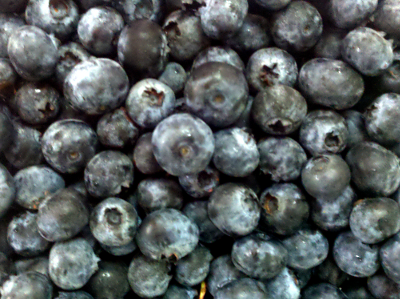 Rob M.
Rob M. | Spring Produce Storage Tips
May 8, 2012 at 1:40 pm |
Blueberries: Of all berries, blueberries tend to keep the longest. First check for any damaged or squashed berries, and remove those from the container, as they will accelerate deterioration of other berries if they are left in. Blueberries should be stored in the refrigerator, or also take very well to freezing for longer term storage.
Strawberries: Check for any damaged or bruised strawberries, and remove them from the container. Damaged fruits release ethylene gas which signals other fruits to ripen at a faster rate. This means that one bad apple really does spoil the bunch. Berries can go bad quite quickly, so make sure they are covered, and store them in the coldest part of the refrigerator. However, strawberries will be at their juiciest at room temperature, so if possible bring them to room temperature prior to consuming.
Beets: Like carrots, beet roots will keep best if the greens are separated from the bulbs. However, the greens will keep longest if kept on the bulb, which will provide the greens with moisture. It's a judgment call as to whether you will do best to remove the greens, or leave them on depending on your uses and timeframes for each. Beet greens will keep for up to a week, whereas bulbs will keep 2-3 weeks, so if in doubt you are probably better off keeping the two together. Beet greens can be used similarly to spinach or chard, and are the most nutritious part of the plant.
Cucumbers: Cucumbers should be refrigerated and kept relatively dry. Over exposure to moisture can cause premature deterioration through mold. This is why English Cucumbers are commonly shrink wrapped, and grocery store cucumbers are often finished with a coat of wax. You can check the life of a cucumber by squeezing the ends. The ends generally turn squishy before the rest of the cucumber, so if they feel soft or start to look wrinkled, the cucumber is coming to the end of its storage life.
Lettuce, heads: Lettuce loves moisture. Remove any wilted leaves, and dampen interior remaining leaves. Place in plastic bag, and store in refrigerator. Hearty lettuces like romaine tend to keep the longest, thinner leafed lettuces tend to wilt faster. If lettuce becomes wilted, you can revive it to an extent in a cold water bath. Fill a sink with cold water and a little ice, and submerge the lettuce for 10-15 minutes. The water will be absorbed by the plant, and can revive leaves that are starting to dry out or wilt. However, watch the lettuce carefully to guard against oversaturation and wet-rot.
Broccoli: Broccoli should be stored in the refrigerator where it will keep for 4-5 days. Like most vegetables, broccoli will lose moisture as it ages, which you want to protect against, but you also want the broccoli to be able to breathe, so it is not a good idea to enclose it in plastic. A perforated plastic bag, or just an open plastic bag are usually the best options. During commercial transport, broccoli is packed on ice which keeps moisture level high, and temperature as close to freezing as possible, while still allowing the broccoli to breathe. However, this usually isn't practical at home. Broccoli takes very well to freezing (if blanched first), so you may consider freezing broccoli if unable to use it within a few days.
Baby Bok Choy: Bok choy is a very versatile green that is commonly steamed, boiled, or stir fried. Full sized bok choy stems should be removed from the leaves and discarded, but baby bok choy stems are usually tender enough for cooking. Baby bok choy stems will likely require a little longer cooking time than leaves, so it is usually a good idea to separate them and cook stems a little longer than bok choy leaves which will just need a few minutes. Boy choy should be refrigerated and will keep for 1-2 weeks.
Carrots: Carrots are hearty vegetable that will keep for an extended period of time. They will keep best if you can avoid moisture loss. Do this by storing carrots in a plastic bag, and by cutting off the greens about an inch or two above the carrots. Carrot greens will suck moisture out of the roots if they are left on. Carrots should also be stored away from fruits, which emit ethylene gas that may cause carrots to develop a bitter taste over time.
Arugula: Arugula is actually an herb in the mustard family. It is generally used similarly to salad greens, either as a substitute or as a complement. Arugula should be kept in a plastic bag to prevent moisture loss, and refrigerated. It will keep for just a few days. Arugula tends to be gritty, so don't forget to wash it just prior to using. If cooked, it should be added in just the last few minutes to prevent flavor loss and overwilting. Arugula makes a great pizza topping!
Radishes: Remove tops from radishes to prevent moisture loss. Radishes should be stored in the refrigerator, and will keep for up to a week. Radishes have a peppery flavor that usually goes well in salads or in appetizers. The peppery flavor stimulated the production of saliva and rouses flavor, making them a good addition to pre-entree dishes. A simple radish appetizers includes sliced radishes served with melted butter and salt on the side. The peppery flavor is most concentrated in the radish skin, so they can be peeled for a milder flavor. Radish greens can also be used raw in salads, or cooked as you would other greens.
Cabbage: If possible, do not remove outer leaves from cabbage. Outer leaves protect interior from damage and from moisture loss. However, if refrigerator space is an issue, you can remove the outer leaves, and will have a smaller head of cabbage, just know that it won't keep quite as well. Cabbage can be used in portions, but once you cut into the interior of the cabbage, you will need to wrap the remaining portion tightly in saran wrap. Cabbage is a versatile vegetable that can be used raw as in coleslaw or cooked in a variety of ways. Cabbage is a food staple and is used in many types of cuisine. Like this? 5.00 (2 ratings) |   (Rob M.) (Rob M.) |